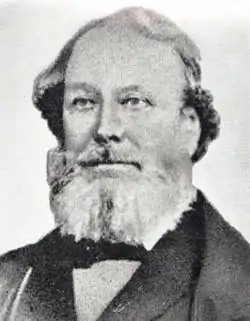John Marshall (cricketer, born 1796)
John Marshall (1796 – 7 September 1876) was an Australian cricketer who played three first-class cricket games for Tasmania.
 | |||||||||||||||||||||||||||
| Personal information | |||||||||||||||||||||||||||
|---|---|---|---|---|---|---|---|---|---|---|---|---|---|---|---|---|---|---|---|---|---|---|---|---|---|---|---|
| Full name | John Marshall | ||||||||||||||||||||||||||
| Born | 1796 England | ||||||||||||||||||||||||||
| Died | 7 September 1876 (aged 79–80) New Town, Tasmania | ||||||||||||||||||||||||||
| Role | Wicket-keeper | ||||||||||||||||||||||||||
| Domestic team information | |||||||||||||||||||||||||||
| Years | Team | ||||||||||||||||||||||||||
| 1850/51–1853/54 | Tasmania | ||||||||||||||||||||||||||
| Career statistics | |||||||||||||||||||||||||||
| |||||||||||||||||||||||||||
Source: Cricinfo, 2 January 2011 | |||||||||||||||||||||||||||
He has the distinction of having captained, and been the wicketkeeper for Tasmania in the first ever first-class cricket match in Australia, which Tasmania won.[1] He stumped the Victorian batsman T.W. Antill for 0 off the bowling of William Henty, making him the first wicket-keeper to effect a stumping in first-class cricket in Australia. His wicket-keeping was described in the Melbourne press as "seldom surpassed in England – almost perfect; as sharp as a needle".[2] Marshall captained Tasmania in all three matches in which he represented the colony, with a record of two wins and one loss.
He was famous for having never cut his beard since his teen years. John Marshall was 58 when he played his last game for Tasmania, holding a record which survives to this day as Australia's oldest ever first-class cricketer. He played for Hobart Town Cricket Club for over twenty years, and was one of their all-time champions, still holding many local records in the Tasmanian Grade Cricket competition.
In 1840 he married a Miss Tabart, daughter of a "gentleman farmer" from Oatlands. He worked for the Bank of Van Diemen's Land, retiring as senior accountant.[3]
John Marshall died on 7 September 1876, in New Town, Tasmania at the age of 80.
References
- Tasmania v Victoria 1850-51
- Quoted in Roger Page, A History of Tasmanian Cricket, Government Printer, Hobart, 1958, p. 22.
- Page, p. 14.